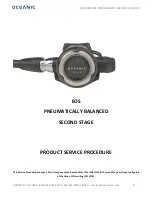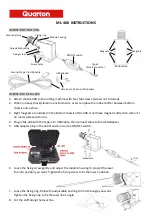
Range, Digits, Rate, and Filter
3-3
Range
The selected range affects both accuracy of the voltage measurement as well as the maximum
voltage that can be measured. The DCV1 function has five measurement ranges; 10mV, 100mV,
1V, 10V, and 100V. The DCV2 function has three measurement ranges; 100mV, 1V, and 10V.
The range setting (fixed or AUTO) is remembered by each voltage function.
NOTE
The available voltage ranges for Ratio (V1/V2) depend on which channel is presently
selected when Ratio is enabled. If Channel 1 is presently selected, DCV1 ranges will
be available when Ratio is enabled. If Channel 2 is presently selected, DCV2 ranges
will be available when Ratio is enabled. Complete information on ranging for Ratio
is provided in
There is no range selection for temperature (TEMP1 and TEMP2) measurements.
Temperature measurements are performed on a single, fixed range. The DIGITS key sets reading
resolution.
Maximum readings
The full scale readings for every voltage range are 20% over range. For example, on the 10V
range, the maximum input voltage is ±12V.
Depending on which type of thermocouple is being used, the maximum temperature readings
range from –200˚C to 1820˚C. The Specifications (
) list the reading range for each
thermocouple type.
Input values that exceed the maximum readings cause the overflow message (“OVRFLW”)
to be displayed.
Manual ranging
To select a range, press the RANGE
or
key. The instrument changes one range per
key-press. The selected range is displayed for one second. Note that the manual range keys have
no effect on temperature (TEMP1 and TEMP2).
If the instrument displays the “OVRFLW” message on a particular range, select a higher
range until an on-range reading is displayed. Use the lowest range possible without causing an
overflow to ensure best accuracy and resolution.
Summary of Contents for 2182
Page 1: ...www tek com keithley Model 2182 2182A Nanovoltmeter User s Manual 2182A 900 01 Rev B May 2017...
Page 18: ......
Page 22: ......
Page 23: ...1 Getting Started Getting Started...
Page 41: ...2 VoltageandTemperature Measurements Voltageand Temperature Measurements...
Page 68: ...2 28 Voltage and Temperature Measurements...
Page 69: ...3 Range Digits Rate andFilter Range Digits Rate andFilter...
Page 82: ...3 14 Range Digits Rate and Filter...
Page 83: ...4 Relative mX b and Percent Relative mX b andPercent...
Page 91: ...5 RatioandDelta Ratioand Delta...
Page 117: ...6 Buffer Buffer...
Page 123: ...7 Triggering Triggering...
Page 140: ...7 18 Triggering...
Page 141: ...8 Limits Limits...
Page 149: ...9 SteppingandScanning Steppingand Scanning...
Page 168: ...9 20 Stepping and Scanning...
Page 169: ...10 AnalogOutput Analog Output...
Page 175: ...11 RemoteOperation Remote Operation...
Page 205: ...12 CommonCommands Common Commands...
Page 221: ...13 SCPISignalOriented Measurement Commands SCPISignalOri entedMeasure ment Commands...
Page 225: ...14 SCPIReferenceTables SCPIRefer enceTables...
Page 239: ...15 AdditionalSCPI Commands Additional SCPICom mands...
Page 260: ...15 22 Additional SCPI Commands...
Page 261: ...A Specifications Specifications...
Page 263: ...B Statusand ErrorMessages StatusandError Messages...
Page 268: ...B 6 Status and Error Messages...
Page 269: ...C Measurement Considerations Measurement Consider ations...
Page 278: ...C 10 Measurement Considerations...
Page 279: ...D Model182Emulation Commands Model182 EmulationCom mands...
Page 284: ...D 6 Model 182 Emulation Commands...
Page 285: ...E Example Programs ExamplePro grams...
Page 293: ...F IEEE 488 BusOverview IEEE 488Bus Overview...
Page 307: ...G IEEE 488andSCPI ConformanceInformation IEEE 488and SCPIConform anceInforma tion...
Page 310: ...G 4 IEEE 488 and SCPI Conformance Information...
Page 311: ...H Measurement Queries Measurement Queries...
Page 316: ...H 6 Measurement Queries...
Page 317: ...I Delta PulseDelta and DifferentialConductance Delta Pulse Deltaand Dif ferentialCon ductance...
















































